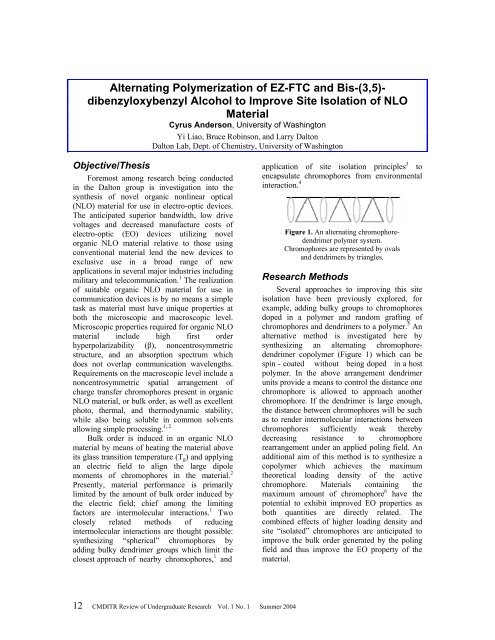CMDITR Review of Undergraduate Research - Pluto - University of ...
CMDITR Review of Undergraduate Research - Pluto - University of ...
CMDITR Review of Undergraduate Research - Pluto - University of ...
You also want an ePaper? Increase the reach of your titles
YUMPU automatically turns print PDFs into web optimized ePapers that Google loves.
Alternating Polymerization <strong>of</strong> EZ-FTC and Bis-(3,5)-<br />
dibenzyloxybenzyl Alcohol to Improve Site Isolation <strong>of</strong> NLO<br />
Material<br />
Cyrus Anderson, <strong>University</strong> <strong>of</strong> Washington<br />
Yi Liao, Bruce Robinson, and Larry Dalton<br />
Dalton Lab, Dept. <strong>of</strong> Chemistry, <strong>University</strong> <strong>of</strong> Washington<br />
Objective/Thesis<br />
Foremost among research being conducted<br />
in the Dalton group is investigation into the<br />
synthesis <strong>of</strong> novel organic nonlinear optical<br />
(NLO) material for use in electro-optic devices.<br />
The anticipated superior bandwidth, low drive<br />
voltages and decreased manufacture costs <strong>of</strong><br />
electro-optic (EO) devices utilizing novel<br />
organic NLO material relative to those using<br />
conventional material lend the new devices to<br />
exclusive use in a broad range <strong>of</strong> new<br />
applications in several major industries including<br />
military and telecommunication. 1 The realization<br />
<strong>of</strong> suitable organic NLO material for use in<br />
communication devices is by no means a simple<br />
task as material must have unique properties at<br />
both the microscopic and macroscopic level.<br />
Microscopic properties required for organic NLO<br />
material include high first order<br />
hyperpolarizability (β), noncentrosymmetric<br />
structure, and an absorption spectrum which<br />
does not overlap communication wavelengths.<br />
Requirements on the macroscopic level include a<br />
noncentrosymmetric spatial arrangement <strong>of</strong><br />
charge transfer chromophores present in organic<br />
NLO material, or bulk order, as well as excellent<br />
photo, thermal, and thermodynamic stability,<br />
while also being soluble in common solvents<br />
allowing simple processing. 1, 2<br />
Bulk order is induced in an organic NLO<br />
material by means <strong>of</strong> heating the material above<br />
its glass transition temperature (T g ) and applying<br />
an electric field to align the large dipole<br />
moments <strong>of</strong> chromophores in the material. 2<br />
Presently, material performance is primarily<br />
limited by the amount <strong>of</strong> bulk order induced by<br />
the electric field; chief among the limiting<br />
factors are intermolecular interactions. 1 Two<br />
closely related methods <strong>of</strong> reducing<br />
intermolecular interactions are thought possible:<br />
synthesizing “spherical” chromophores by<br />
adding bulky dendrimer groups which limit the<br />
closest approach <strong>of</strong> nearby chromophores, 1 and<br />
application <strong>of</strong> site isolation principles 3 to<br />
encapsulate chromophores from environmental<br />
interaction. 4<br />
Figure 1. An alternating chromophoredendrimer<br />
polymer system.<br />
Chromophores are represented by ovals<br />
and dendrimers by triangles.<br />
<strong>Research</strong> Methods<br />
Several approaches to improving this site<br />
isolation have been previously explored, for<br />
example, adding bulky groups to chromophores<br />
doped in a polymer and random grafting <strong>of</strong><br />
chromophores and dendrimers to a polymer. 5 An<br />
alternative method is investigated here by<br />
synthesizing an alternating chromophoredendrimer<br />
copolymer (Figure 1) which can be<br />
spin - coated without being doped in a host<br />
polymer. In the above arrangement dendrimer<br />
units provide a means to control the distance one<br />
chromophore is allowed to approach another<br />
chromophore. If the dendrimer is large enough,<br />
the distance between chromophores will be such<br />
as to render intermolecular interactions between<br />
chromophores sufficiently weak thereby<br />
decreasing resistance to chromophore<br />
rearrangement under an applied poling field. An<br />
additional aim <strong>of</strong> this method is to synthesize a<br />
copolymer which achieves the maximum<br />
theoretical loading density <strong>of</strong> the active<br />
chromophore. Materials containing the<br />
maximum amount <strong>of</strong> chromophore 6 have the<br />
potential to exhibit improved EO properties as<br />
both quantities are directly related. The<br />
combined effects <strong>of</strong> higher loading density and<br />
site “isolated” chromophores are anticipated to<br />
improve the bulk order generated by the poling<br />
field and thus improve the EO property <strong>of</strong> the<br />
material.<br />
12 <strong>CMDITR</strong> <strong>Review</strong> <strong>of</strong> <strong>Undergraduate</strong> <strong>Research</strong> Vol. 1 No. 1 Summer 2004




